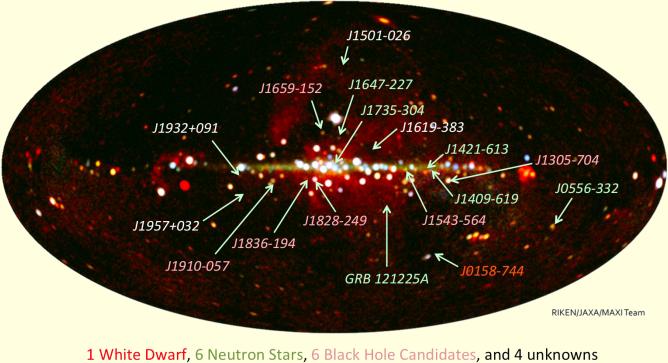- Indico style
- Indico style - inline minutes
- Indico style - numbered
- Indico style - numbered + minutes
- Indico Weeks View
7 years of MAXI : monitoring X-ray transients
→
Asia/Tokyo
Suzuki Umetaro Hall (RIKEN)
Suzuki Umetaro Hall
RIKEN
2-1 Hirosawa, Wako, Saitama, 351-0198, Japan
Description
Thank you for your participation!
We had 143 participants.
7 years of MAXI : monitoring X-ray transients
5-7 December,2016
Suzuki Umetaro Hall, RIKEN
2-1 Hirosawa, Wako, Saitama, 351-0198, Japan
RIKEN symposium
17 X-ray Novae in 6 years by MAXI
This workshop will be held to celebrate the successful 7 years of observation with Monitor of All-sky X-ray Image (MAXI), a Japanese astrophysics payload on the International Space Station. Since the launch in 2009, MAXI has been monitoring the variable X-ray sky, and has discovered 17 new X-ray sources.
Often with a help of multi-wavelength follow-up observations, one of them has been identified with the nuclear ignition of a massive nova, 6 with black-hole binaries, and 5 with those involving neutron stars.
Nevertheless, 4 of them remain unidentified, and are considered to form a potentially new class of short soft transients. MAXI is also leading the time-domain astronomy, with its capability to issue alerts which triggers prompt follow-up observations in the optical and other wavelengths.
So far, MAXI has detected about a hundred gamma-ray bursts, and performing unbiased watch for stellar flares. In addition, long-term X-ray variations of about a hundred of sources are continuously tracked with MAXI.
This has enabled a variety of new astrophysics that cannot be achieved by snapshot observations. The recent detections of the gravitation wave events have significantly increased the importance of MAXI as a currently operating all-sky monitor, and as a member of multi-messenger astronomy which covers electromagnetic waves, neutrinos, and gravitational waves.
In this symposium, the MAXI results obtained during the 7 years are reviewed, with a session assigned to those from Hitomi. The symposium also covers new prospects in the time-domain astronomy, to be developed with future X-ray missions/instruments.
Topics - MAXI transients - Stellar Mass BH - AGN - Low Mass X-ray Binaries - Superbursts - Binary X-ray Pulsars - Stellar Flares - Hitomi Results - GRB - Gravitational Wave Sources Confirmed speakers - Paul Biswajit (Raman Research Institute, India) - Chris Done (University of Durham, UK) - Ken Ebisawa (ISAS, Japan) - Jean in 't Zand (SRON, Netherlands) - Peter Jenke (UAH/CSPAR, USA) - Nobuyuki Kawai (Tokyo Tech., Japan) - Taiki Kawamuro (Kyoto univ., Japan) - Jamie Kennea (Pennsylvania State Univ., USA) - Alex Markowitz (UC, San Diego, USA) - Tatehiro Mihara (RIKEN, Japan) - Motoki Nakajima (Nihon dent. col., Japan) - Hitoshi Negoro (Nihon Univ., Japan) - Jerome Rodroguez (CEA Saclay, France) - Leo Singer (GSFC/NASA, USA) - Takanori Sakamoto (Aoyama Gakuin Univ., Japan) - Motoko Serino (RIKEN, Japan) - Kazunari Shibata (Kyoto Univ., Japan) - Mutsumi Sugizaki (RIKEN, Japan) - Hiromitsu Takahashi (Hiroshima Univ., Japan) - Yohko Tsuboi (Chuo Univ., Japan) - Hiroshi Tsunemi (Osaka Univ., Japan) - Alexander van der Horst (George Washington Univ., USA) - Weimin Yuan (National astronomical observatory, China) - Shuangnan Zhang (High energy research institute, China)
Support
This symposium is supported by RIKEN through the RIKEN Symposium scheme,
and by the Society for Promotion of Space Science (宇宙科学振興会) through
the program for supporting international symposia (国際会議開催支援プログラム).
Participants
Aarran Shaw
Ai Sakamaki
Alex Markowitz
Alexander van der Horst
Andrea Santangelo
Anna Ho
Argha Jit JANA
Atsumasa Yoshida
Atsushi Tanimoto
Biswajit Paul
Chifumi hanyu
Chiho Okada
Chris Done
Dipak Debnath
Enrico Bozzo
Erlin Qiao
Eva Laplace
Gaurava Kumar Jaisawal
Hajime Inoue
Haruka Ohuchi
Hideki Hayashi
Hideki Uchiyama
Hirofumi Noda
Hiromitsu Takahashi
Hiroshi Nakajima
Hiroshi Tomida
Hiroshi Tsunemi
Hitoshi Negoro
Jamie Kennea
Jean in 't Zand
Jerome Rodriguez
Jin MATSUMOTO
Jose Joaquin Rodes Roca
Jose M. Torrejon
Juri Sugimoto
Katsuma Miyake
Kazuhiro Nakazawa
Kazuki Tanaka
Kazumi Asai
Kazunari Shibata
Kazuo Makishima
Kazutaka Yama
Kazutaka Yamaoka
Ken Ebisawa
Ken Ebisawa
Ken Yabuki
Kenichiro Furuya
Kensei Shiki
Kentaro Wada
Kiyoshi Hayashida
Ko Ono
Koji Mori
Koji Tanaka
Kosuke Sato
Kouichi Hagino
Kouki hidaka
Koyo Toda
Leo Singer
Magnus Axelsson
Makoto Sawada
Makoto Tashiro
Makoto Yamauchi
Manabu Ishida
Manami Seino
Mariko Kimura
Masa Sakano
Masanori Ohno
Masanori Ohno
Masaru Matsuoka
Megumi Shidatsu
Mikio Morii
Motoki Nakajima
Motoko Serino
Murli Manohar Verma
Mutsumi Sugizaki
Mutsumi Sugizaki
Nagomi Uchida
Naoki Isobe
Nazma Islam
Nobuyuki Kawai
Nobuyuki Kawai
Norisuke Ohmori
Osamu Nishimura
Peter Jenke
Pragati Pradhan
Robin Corbet
Ryo Sasaki
Ryosuke Itoh
Saeko Oda
Sam Connolly
Satoru Katsuda
Satoshi Nakahira
Satoshi Sugita
Seiya Yabe
Shinya Nakashima
Shohei Harita
Shuang-Nan Zhang
Shuang-Nan Zhang
Siti Fatima
Stephane CORBEL
Susumu Inoue
Tae Furusho
Taichi Fujiwara
Taiki Kawamuro
Takafumi Hori
Takahiro Masumitsu
Takanori Sakamoto
Takashi Nakamura
Takaya Ohashi
Takayuki Yamamoto
Taketoshi Yoshii
Tatehiro Mihara
Tatsuya Sawano
Teruaki Enoto
Tomofumi Kawase
Tomokage Yoneyama
Tomoya Kinugawa
Toru Tamagawa
Toshihiro Takagi
Toshikazu Shigeyama
Toshio Nakano
Wataru Iwakiri
Weimin Yuan
Yasuharu Sugawara
Yasushi Fukazawa
Yohko Tsuboi
Yoshihiro Ueda
Yoshiki Kitaoka
Yuji Urata
Yuki Ono
Yumiko Nakamura
Yusuke Yamada
Yuta Kawakubo
Yutaro Tachibana


